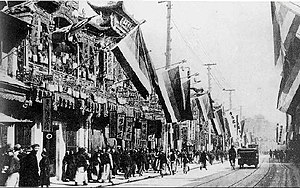Revolution of 1911
| Xinhai Revolution (Chinese Revolution) | |||||||
|---|---|---|---|---|---|---|---|
| Part of Anti-Qing Movements | |||||||
 Double Ten Revolution in Shanghai. The picture above is Nanjing Road (Nanking Road) after the Shanghai Uprising, hung with the Five Races Under One Union flags then used by the revolutionaries. |
|||||||
|
|||||||
| Belligerents | |||||||
|
|
|
||||||
| Commanders and leaders | |||||||
|
Various other nobles of the Qing dynasty |
|
||||||
| Strength | |||||||
| 200,000 | 100,000 | ||||||
| Casualties and losses | |||||||
| ~170,000 | ~50,000 | ||||||
| Xinhai Revolution | |||||||||||||||||||||||

"Xinhai Revolution" in Chinese characters
|
|||||||||||||||||||||||
| Chinese | 辛亥革命 | ||||||||||||||||||||||
|---|---|---|---|---|---|---|---|---|---|---|---|---|---|---|---|---|---|---|---|---|---|---|---|
| Literal meaning | "Xinhai (stem-branch) revolution" | ||||||||||||||||||||||
|
|||||||||||||||||||||||
| Transcriptions | |
|---|---|
| Standard Mandarin | |
| Hanyu Pinyin | Xīnhài gémìng |
| Wade–Giles | Hsin1-hai4 kê2-ming4 |
| IPA | [ɕín.xâi kɤ̌.mîŋ] |
| Yue: Cantonese | |
| Yale Romanization | Sān-hoih gaak-mihng |
| IPA | Cantonese pronunciation: [sɐ́n hɔ̀ːi kāːk mɪ̀ŋ] |
| Jyutping | San1-hoi6 gaak3-ming6 |
| Southern Min | |
| Hokkien POJ | Sen-hāi kek-bēng |
The Xinhai Revolution (Chinese: 辛亥革命; pinyin: Xīnhài gémìng), also known as the Chinese Revolution or the Revolution of 1911 was a revolution that overthrew China's last imperial dynasty (the Qing dynasty), and established the Republic of China (ROC). The revolution was named Xinhai (Hsin-hai) because it occurred in 1911, the year of the Xinhai (辛亥, metal pig) stem-branch in the sexagenary cycle of the Chinese calendar.
The revolution consisted of many revolts and uprisings. The turning point was the Wuchang Uprising on October 10, 1911, which was the result of the mishandling of the Railway Protection Movement. The revolution ended with the abdication of the six-year-old "Last Emperor", Puyi, on February 12, 1912, that marked the end of 2,000 years of imperial rule and the beginning of China's early republican era (1912–16).
The revolution arose mainly in response to the decline of the Qing state, which had proven ineffective in its efforts to modernize China and confront foreign aggression. Many underground anti-Qing groups, with the support of Chinese revolutionaries in exile, tried to overthrow the Qing. The brief civil war that ensued was ended through a political compromise between Yuan Shikai, the late Qing military strongman, and Sun Yat-sen, the leader of the Tongmenghui (United League). After the Qing court transferred power to the newly founded republic, a provisional coalition government was created along with the National Assembly. However, political power of the new national government in Beijing was soon thereafter monopolized by Yuan and led to decades of political division and warlordism, including several attempts at imperial restoration.
...
Wikipedia
